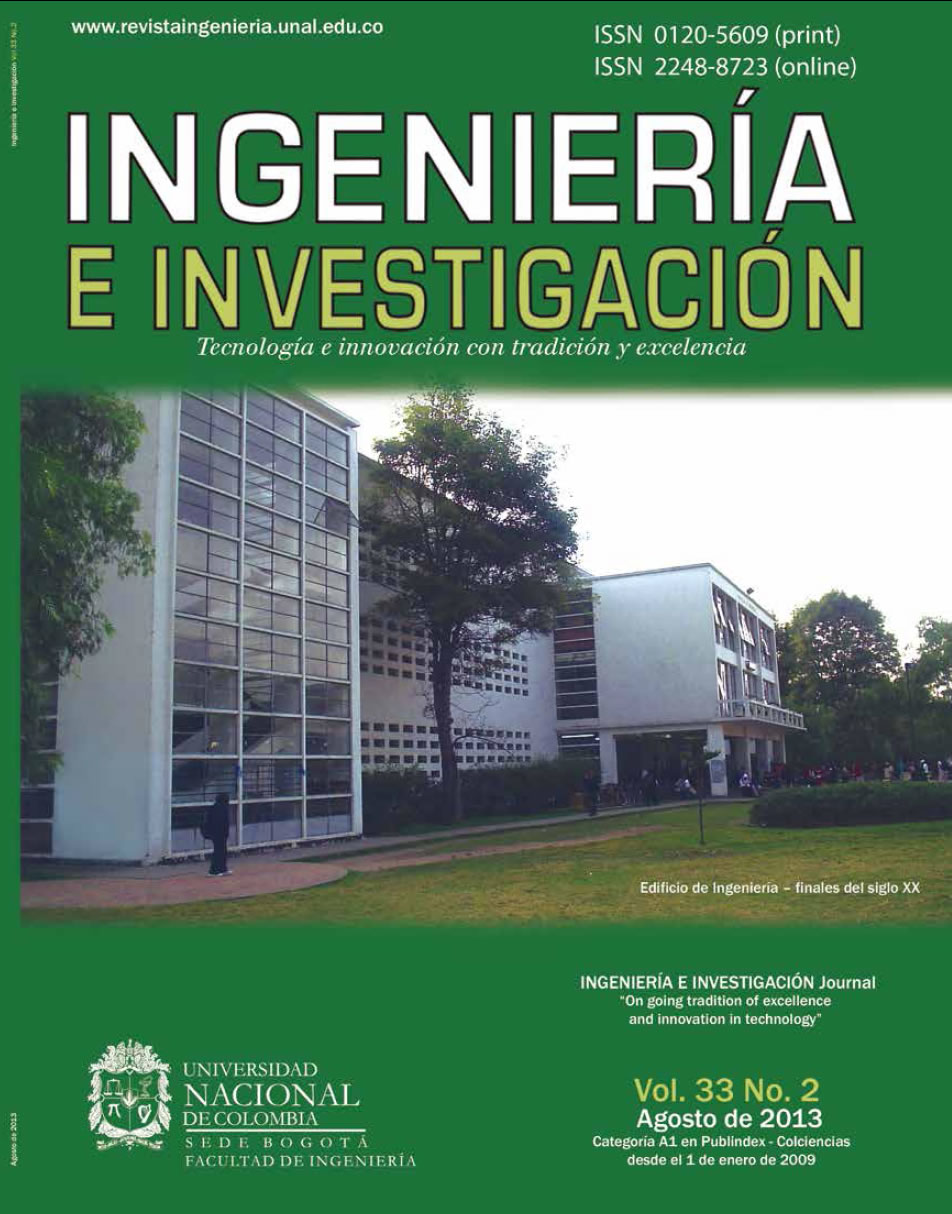Urban air pollution in school-related microenvironments in Bogota, Colombia
Caracterización de la calidad del aire en microambientes de colegios distritales en Bogotá
DOI:
https://doi.org/10.15446/ing.investig.v33n2.39516Keywords:
Traffic-related air pollution, air quality, children’s exposure, urban sustainability (en)Calidad del aire, tráfico vehicular, exposición a la contaminación atmosférica, sostenibilidad urbana (es)
Particle-related pollution (PM10, PM2.5 and soot) was measured in both indoor and outdoor microenvironments at four public elementary schools in Bogotá, Colombia. Three of these schools were located alongside major urban roads in which different types of public transit systems are used (bus rapid transit system and conventional transit buses). The fourth school was located on a non-congested road (background school). Pollutant levels at schools situated on major-roads were higher than those found at the low-congestion-road school. Outdoor black carbon daily mean concentrations at the schools located near major roads were up to six times higher than those recorded at the background school. Mean particulate matter concentrations at schools near major roads were above international standards, suggesting that school-age children in Bogotá are exposed to pollution levels that are considered to be harmful by environmental and public health authorities. Elevated indoor and outdoor pollutant concentrations documented in this study suggested that traffic has a direct impact on air quality regarding the schools' characterised microenvironments.
Se caracterizaron los niveles de material particulado respirable (PM10), material particulado fino (PM2.5) y carbono elemental (BC) en microambientes intramurales y exteriores de cuatro colegios distritales en Bogotá. Tres de estos colegios estaban ubicados en inmediaciones de vías principales consideradas de alto tráfico vehicular, por las que circulan distintos tipos de transporte público (colectivo convencional y transporte público masivo). El colegio restante (utilizado como sitio control) se encontraba ubicado sobre una vía secundaria, no congestionada. En general, los niveles de contaminación encontrados en los microambientes de los colegios ubicados en vías con alto tráfico vehicular fueron significativamente mayores que aquellos reportados en el colegio control. Por ejemplo, las concentraciones de BC documentadas en microambientes exteriores de los colegios ubicados sobre vías principales fueron hasta seis veces mayores que aquellas encontradas en el colegio control. Las concentraciones promedio reportadas sugieren que los menores en edad escolar en Bogotá se encuentran expuestos a niveles de contaminación considerados como nocivos para la salud por las autoridades internacionales. Adicionalmente, la evidencia recolectada propone que en los colegios evaluados, el tráfico vehicular tiene un impacto importante en la calidad del aire al interior de los mismos.
J. F. Franco1, N. Y. Rojas2, O. L. Sarmiento3 and E. Behrentz4
1 Juan Felipe Franco. M. Sc. Affiliation: Universidad EAN, Colombia. E-mail: jffranco@ean.edu.co
2 Néstor Yesid Rojas. Ph. D. Affiliation: Universidad Nacional de Colombia, Colombia. E-mail: nyrojasr@unal.edu.co
3 Olga Lucía Sarmiento. Ph. D. Affiliation: Universidad de los Andes, Colombia. E-mail: osarmien@uniandes.edu.co
4 Eduardo Behrentz. Ph. D. Affiliation: Universidad de los Andes, Colombia. E-mail: ebehrent@uniandes.edu.co
How to cite: Franco, J. F., Rojas, N. Y., Sarmiento, O. L., Behrentz, E., Urban air pollution in school-related microenvironments in Bogota, Colombia., Ingeniería e Investigación. Vol. 33, No. 2. August 2013, pp. 42 - 48.
ABSTRACT
Particle-related pollution (PM10, PM2.5 and soot) was measured in both indoor and outdoor microenvironments at four public elementary schools in Bogota, Colombia. Three of these schools were located alongside major urban roads in which different types of public transit systems are used (bus rapid transit system and conventional transit buses). The fourth school was located on a non-congested road (background school). Pollutant levels at schools situated on major-roads were higher than those found at the low-congestion-road school. Outdoor black carbon daily mean concentrations at the schools located near major roads were up to six times higher than those recorded at the background school. Mean particulate matter concentrations at schools near major roads were above international standards, suggesting that school-age children in Bogota are exposed to pollution levels that are considered to be harmful by environmental and public health authorities. Elevated indoor and outdoor pollutant concentrations documented in this study suggested that traffic has a direct impact on air quality regarding the schools' characterised microenvironments.
Keywords: Traffic-related air pollution, air quality, children's exposure, urban sustainability.
RESUMEN
Se caracterizaron los niveles de material particulado respirable (PM10), material particulado fino (PM2.5) y carbono elemental (BC) en microambientes intramurales y exteriores de cuatro colegios distritales en Bogotá. Tres de estos colegios estaban ubicados en inmediaciones de vías principales consideradas de alto tráfico vehicular, por las que circulan distintos tipos de transporte público (colectivo convencional y transporte público masivo). El colegio restante (utilizado como sitio control) se encontraba ubicado sobre una vía secundaria, no congestionada. En general, los niveles de contaminación encontrados en los microambientes de los colegios ubicados en vías con alto tráfico vehicular fueron significativamente mayores que aquellos reportados en el colegio control. Por ejemplo, las concentraciones de BC documentadas en microambientes exteriores de los colegios ubicados sobre vías principales fueron hasta seis veces mayores que aquellas encontradas en el colegio control. Las concentraciones promedio reportadas sugieren que los menores en edad escolar en Bogotá se encuentran expuestos a niveles de contaminación considerados como nocivos para la salud por las autoridades internacionales. Adicionalmente, la evidencia recolectada propone que en los colegios evaluados, el tráfico vehicular tiene un impacto importante en la calidad del aire al interior de los mismos.
Palabras clave: Calidad del aire, tráfico vehicular, exposición a la contaminación atmosférica, sostenibilidad urbana.
Received: October 31th 2012 Accepted: July 12th 2013
Introduction
Reducing air pollution is considered an environmental challenge in major cities around the world (Chow et al., 2004; Bell et al., 2006; Siemens, 2008). Bogota, Colombia's capital city, has been ranked as one of the most air-polluted cities in Latin-America (WHO, 2005; EIU, 2011). Like many other cities in developing countries, its ambient inhalable particulate matter (PM10) concentrations are well above local and national air quality standards (Gaitan et al., 2007; SDA, 2012). Local environmental and public health authorities are aware of this problem and are keen to find an effective solution, especially since it has already been documented that respiratory illness is the main cause for morbidity and mortality in the city amongst children below five years of age (SDS, 2009).
It has been well-documented that children are especially sensitive to the harmful effects of air pollution (Calderón-Garciduena et al., 2003; Kim, 2004; Schwartz, 2004; Pope et al., 2006). Evidence suggests that children whose homes or schools are located nearby congested roads tend to exhibit respiratory complications leading to a reduction in their pulmonary function (Caderón-Garciduenas et al., 2006; Kim et al., 2004; Jansen et al., 2001; Fritz and Herbarth, 2001; Peters et al., 1999). International studies related to air quality in schools have documented PM levels exceeding World Health Organisation (WHO) guidelines (Fromme et al., 2007; Van Roosbroeck et al., 2007; Blondeau et al., 2005).
This study's main objective was to characterise urban atmospheric pollution in different microenvironments at elementary schools in Bogota. It is hoped that the evidence presented herein will be used for supporting environmental and public health authorities' formulation of plans of action.
Methods
School selection and sampling sites
The study was conducted in the urban area of Bogota (Colombia's capital and largest city), located 2,600 m above sea level on the Andes mountain range. The city's annual average temperature is 15oC, having alternate periods of rain and drought. Bogota has one of the highest population densities in the Americas, with close to 8,000,000 people living in less than 30,000 hectares of urbanised area (DANE, 2011). The population is classified into six socioeconomic strata defined according to neighbourhood's SES (strata 1 being the poorest and strata 6 the wealthiest), most people (close to 80%) living in neighbourhoods classified in strata 2 and 3, 10% residing in neighbourhoods classified as strata 4 and 5 and the remainder living in neighbourhoods categorised as strata 1 or 6 (DAPD, 2007). Most journeys in the city (60%) involve using public transport. Bogota's economy represents about 25% of the country's gross domestic product (Luna and Behrentz, 2011).
Four schools were selected from the city's public elementary school network, consisting of about 1,000 schools. A complete description of the school selection procedure is given elsewhere (Franco et al., 2009). Many of the public network schools are located alongside secondary roads. However, a significant number of such schools are built along main urban roads on which diesel-fuelled transit buses are abundant.
One of the four selected schools was located on a low-traffic road, which was considered as a background site (School 1). The other three schools were located beside major roads, characterised by heavy vehicle traffic, including diesel buses and trucks. Two of these schools were on roads where conventional traffic buses (CTB) still represent the predominant public transportation system (School 2 and School 3). The remaining school was located at the side of a roadway where a bus rapid transit (BRT) system is already in place (School 4).
All four schools were situated in areas having no industry or other stationary air pollution sources. The background school was located in a low air pollution area and the schools near major roads were located in areas having high particulate matter concentrations, according to urban background measurements recorded by the city's air-quality monitoring network. School buildings and classroom furniture were similar amongst the studied schools. Typical building construction materials included concrete, brick and cement. As usual in school buildings in Bogota, none of them were equipped with artificial ventilation or air conditioning systems. Classroom windows remained closed during class-time to avoid traffic-related noise. Hard surface floorings were used in all indoor school micro-environments.
Two different types of school-related microenvironments were characterized: 1) Outdoor microenvironments (the closest point to the roadway within the school property as well as the playgrounds) and 2) Indoor microenvironments (classrooms).
Traffic count
Traffic count and categorisation were made for all roads where the participating schools were located. A digital video camera placed in front of each school documented vehicle traffic four hours per day (two hours in the morning and two in the afternoon), three days per week. The number of vehicles was determined for each testing day as well as the composition of the fleet based on the following vehicle categories: passenger cars, trucks, motorcycles, CTB and BRT. All videos were analysed several times by different people and an intra-class correlation coefficient was obtained for assessing consistency between independent counts.
Air pollution measurement
Air pollutant concentration was measured during a field campaign between 2006 and 2008 (a three-month field campaign every year). Integrated 8-hour PM10, 8-hour real-time PM10 and fine particulate matter (PM2.5), and 8-hour real-time black carbon (BC) measurements were taken. Real-time PM10 and PM2.5 measurements were made using two co-located portable refractometers (DustTrak 8520, TSI Inc., St. Paul, MN, USA). Both instruments were configured to collect minute-by-minute data. BC measurements were made using a portable Aethalometer (Magee Scientific Co., Berkeley, CA, USA). Minute-by-minute readings were recorded in the device's internal memory.
DustTrak measurements were validated by running collocated gravimetric-based measurements using MS&T samplers - Harvard Impactors (Air Diagnostics and Engineering Inc., Harrison, ME, USA) operating at 10 litres per minute (lpm) flow rate. A high-accuracy Matheson rotameter (model FM-1050) was used for verifying instrument flow-rate before and after the experiments. PM10 concentrations were determined gravimetrically, weighing 37-mm teflon filters (2 micron pore-size) with a microbalance (Sartorius, M5P-000V001). Samples were kept in controlled conditions regarding temperature (23±1oC) and relative humidity (45%) 24 to 48 hours before weighing.
Integrated and real-time samples were taken daily (between 7:00 a.m. and 3:00 p.m.), matching school hours, during a period of at least four weeks at each school (excluding weekends). The measurements were not taken simultaneously at all schools. The instruments measuring position were about 1.5 m above floor level. Table 1 shows the number of experiments at each school.
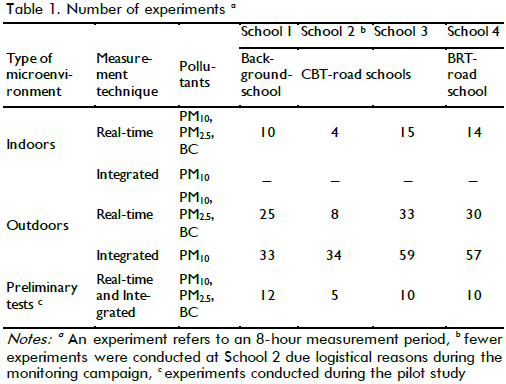
Together with the field measurements, data from city's air quality monitoring network was collected. PM10 concentrations at the closest station to each school was documented and analyzed in order to establish a background scenario for every site. The procedure and the results of these measurements are published elsewhere (Franco et al., 2009).
Statistical analysis
PM and BC concentration datasets were created and validated using data quality assurance procedures. Results from school 2 and 3 (both located alongside CTB roads) were grouped together and are presented as a single case. Cumulative frequency distributions were determined and plotted. Real time concentrations were summarised to 8-hour means and medians for each studied microenvironment. Univariate distribution analysis was carried out to identify potential outliers. Descriptive statistics were computed for all pollutant concentrations. Linear regression for PM2.5-to-PM10 concentration ratios concerning outdoor and indoor microenvironments was performed and correlation coefficients (R2) were estimated.
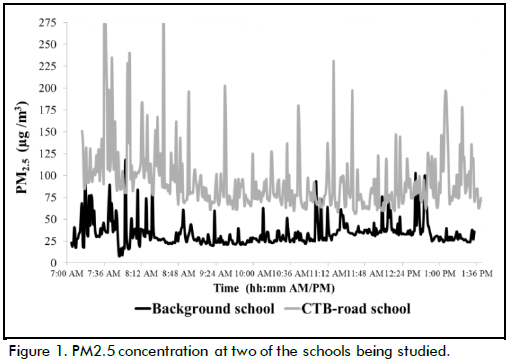
Figure 2 shows the cumulative frequency distribution for all outdoor pollutant concentrations documented during the monitoring campaign (based on real-time measurements). Outdoor PM and BC concentrations at major-road schools were significantly higher than those found at the background school. Pollutant concentration at schools located on roads dominated by CTB was higher than that at the school located on the road used by the BRT system. These results were proportional to the flow of diesel-powered traffic on each type of road, and may have been an indicator of the environmental co-benefits of implementing BRT as a public transport system.
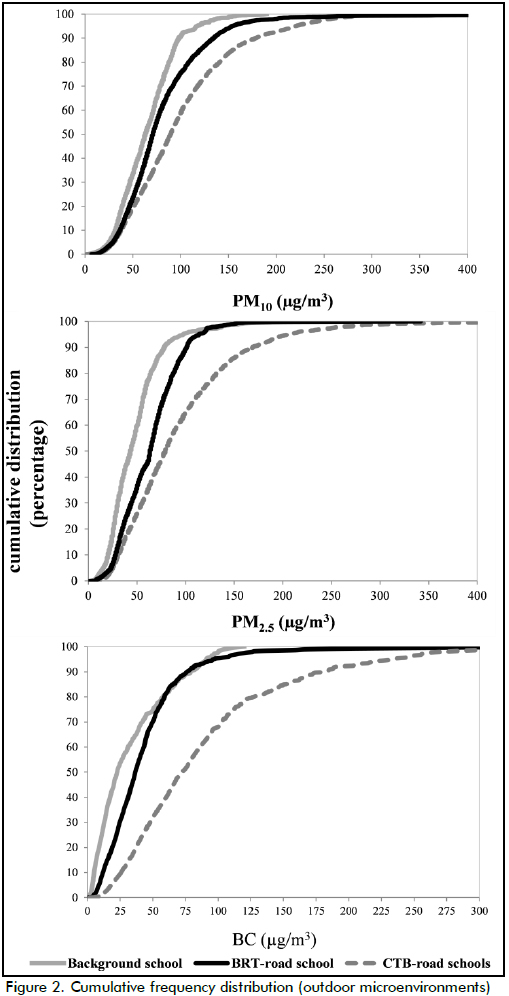
A high percentage of instantaneous PM concentration (see Figure 2) was above WHO reference values (i.e. concentrations considered harmful for the population). Only about 20% of the outdoor PM10 concentrations registered at schools located alongside major roads were below 50 µg/m3 (WHO 24-hour reference for PM10) and less than 10% of the instantaneous PM2.5 concentrations were below 25 µg/m3 (WHO 24-hour reference for PM2.5). Even at the background school, around 40% and 20% of the outdoor PM10 and PM2.5 concentrations, respectively, were below WHO standards. These findings highlighted the importance of the situation, given that children typically spend about one third of their day at school. The authors understand that WHO guidelines are recommended concentration limits concerning a specific period of time (i.e. 24 hours); however, these values were used as reference for comparing the pollution levels found at schools in this research.
Figure 3 shows the 95% confidence interval for outdoor PM10, PM2.5 and BC concentrations at the schools being studied. Consistent with the results shown in Figure 2, outdoor pollutant concentrations at the background site were significantly lower than at congested-road schools (outdoor PM10 and PM2.5 mean concentrations at busy-road schools were up to 1.6- and 1.8-fold higher, respectively, than at the background school).
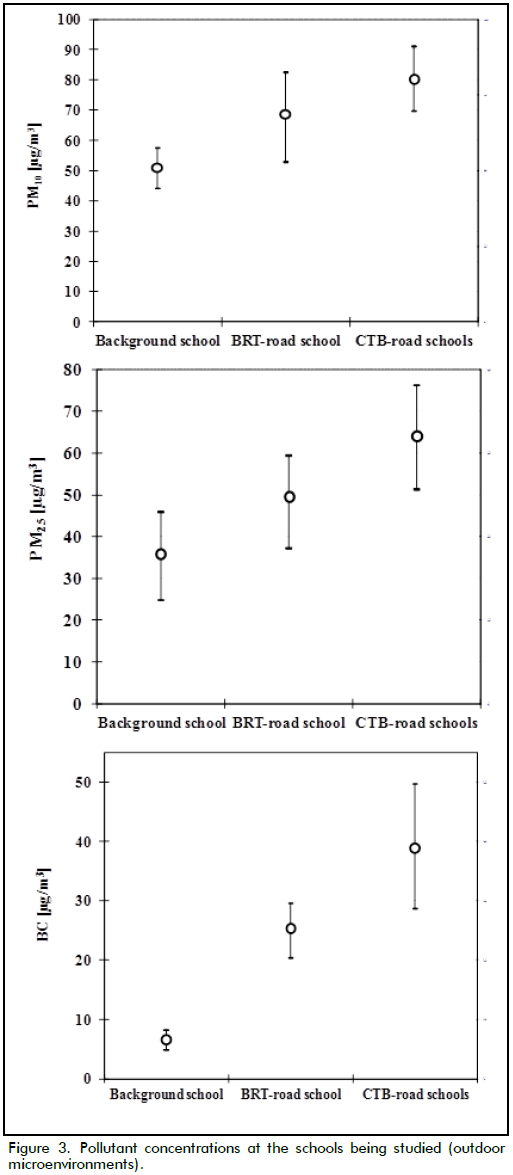
Outdoor BC mean concentrations at schools located beside major roads used by CTB were up to 6-fold higher than those found at the background site. Such concentrations were also 1.6-fold higher than those recorded at the school located beside the road used by the BRT system. Given that BC has been recognised as an indicator of diesel combustion emissions (Fruin et al., 2004; Kirchestter et al., 2008), the aforementioned differences could be attributed to differences in the number of diesel-powered vehicles (especially buses) on the studied roads (see Table 2).
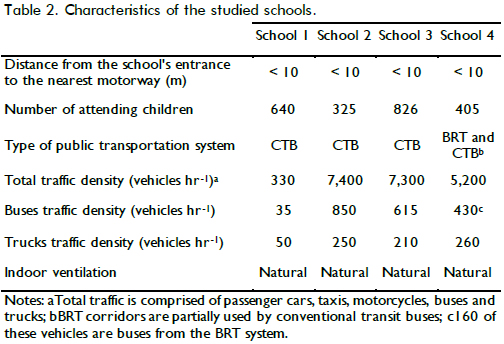
For the city's urban planning agency, this evidence supports the fact that elementary schools should not be built along major roads. Given that a BRT system implies newer and larger buses replacing an old, chaotic bus fleet, these results may be used for defining environmental co-benefits associated with a BRT system in Bogota. This was consistent with previous research conducted in the city (CCB, 2006) in which significant differences in PM10 concentration along two major roads were related to the type of public transport system (CTB and BRT). More research is needed, however, to formally quantify the environmental impact related to changes in Bogota's public transport system, and that of other major cities in the developing world.
The outdoor PM and BC concentration ranges documented in this study were higher than those reported by previous peer-reviewed literature (Janssen et al., 2001; Kim et al., 2004; Van Roosbroeck et al., 2007). Janssen et al., studied traffic-related air pollution at 24 schools located near motorways in the Netherlands. The authors found a significant increase in PM2.5 and BC concentration with increasing truck traffic density and decreasing school distance to the nearest motorway. They reported outdoor PM2.5 concentration as being 5 µg/m3 to 61 µg/m3 (using gravimetric techniques) and BC concentration from 1 µg/m3 to 25 µg/m3.
Kim et al., measured traffic-related pollutants at 10 schools in San Francisco, California, as part of a cross-sectional study; they reported average 30 µg/m3 (PM10), 12 µg/m3 (PM2.5) and 0.8 µg/m3 (BC) concentrations for the studied schools. Van Roosbroeck et al., measured children's personal exposure to traffic-related air pollutants in schools located within 100 m of a major urban road in the Netherlands. Parallel to these exposure measurements, they monitored outdoor pollutant levels at each school. They reported mean 19 µg/m3 PM2.5 concentration (using gravimetric techniques) and 16 µg/m3 BC mean concentration. They also found outdoor BC concentration to be 75% higher at the major-road schools compared to the matched background school.
Indoor microenvironments: Figure 4 shows the cumulative frequency distribution for indoor pollutant concentration. Regarding BC, busy-road schools had higher concentrations and CTB-road schools were the most critical case. PM results, however, revealed a slightly different pattern. For such pollutant, especially PM10, the BRT-road school microenvironment had the highest concentrations. These differences (BC cf PM) suggested the presence of indoor PM sources which were not related to diesel traffic.
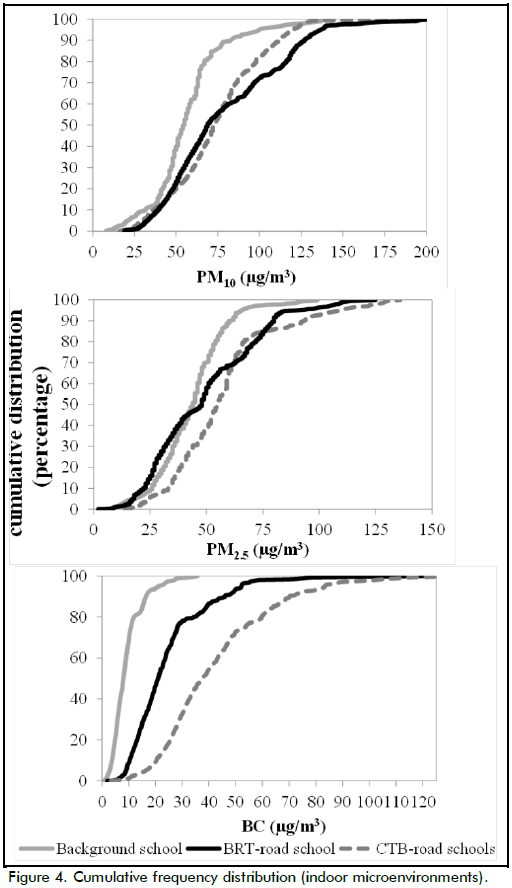
Indoor ventilation was limited for the schools being studied, in particular at busy-road schools where most classroom doors and windows remained closed during class hours to avoid traffic-related noise. Such conditions may have contributed towards increased indoor pollution, not only due to proximity to congested roads but also to room occupancy and activities, such as sweeping up during class breaks (observed during the monitoring campaign). Similar circumstances have been discussed by other authors (Blondeau et al., 2005, Branis et al., 2005, Heudorf et al., 2009) as indoor air-quality determinant.
Figure 5 shows the 95% confidence intervals for indoor PM10, PM2.5 and BC mean concentrations at the studied schools. Indoor PM10 mean concentrations at major-road schools were up to 1.6-fold higher than those found at the background school. Also, indoor BC concentrations were up to 3-fold higher at busy-road schools than those recorded in indoor microenvironments at the background site. Nonetheless, no difference was found for indoor PM2.5 concentration among schools. Comparing outdoor and indoor BC data at the background school, concentration levels showed no decay, as was expected under the assumption that the impact of the nearby road on air pollution would have been very low.
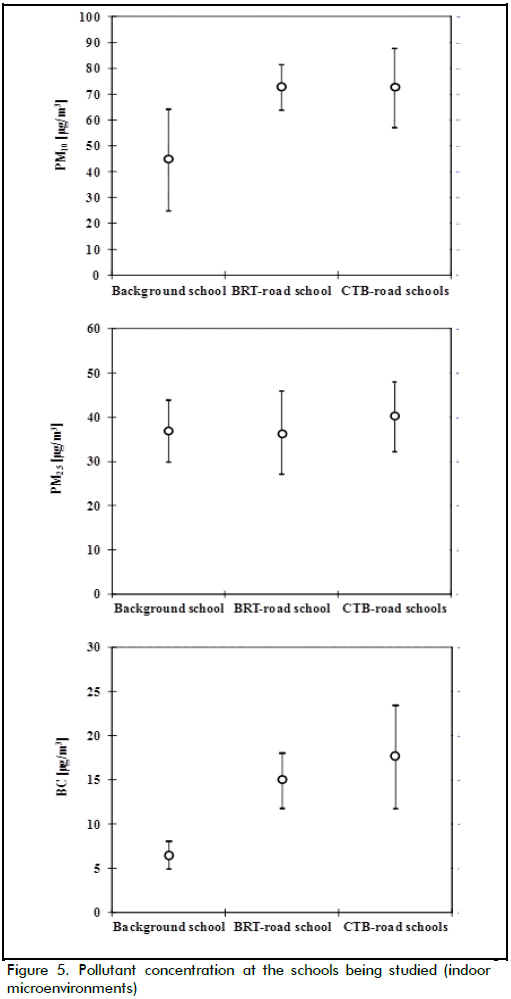
The high indoor concentrations found at schools also indicated a great need for reduction. It should be suggested that local authorities study using feasible strategies for reducing air pollution and mitigate its negative effects. For example, introducing air cleaners in classrooms, together with mechanical ventilation systems, would represent an alternative. There is also a need for identifying other factor affecting indoor air quality in schools in Bogota. Construction materials, classroom size and occupancy are variables which should be included and quantified in further local research.
PM2.5 to PM10 ratio
Table 3 summarises the results for the PM2.5-to-PM10 ratio. Such ratio can differ significantly due to a variety of factors including distance from a road, meteorological conditions and indoor ventilation. The values determined in this study ranged from 0.73 to 0.81 for outdoor microenvironments and from 0.58 to 0.78 for indoor microenvironments. PM10 and PM2.5 concentrations were highly correlated (R2 = 0.86 and 0.91) in the studied microenvironments. These results indicated that fine particles represent a significant fraction of the PM levels documented in this study. Such relatively high PM2.5:PM10 ratios demonstrated the impact of traffic-related emissions on overall pollutant concentrations in the characterised microenvironments inside the schools. These results were consistent with ranges reported as being typical PM2.5:PM10 ratios for urban areas of the developing world (from 0.50 to 0.80) (Shprentz, 1996; WHO, 2005; Godoy et al., 2009).
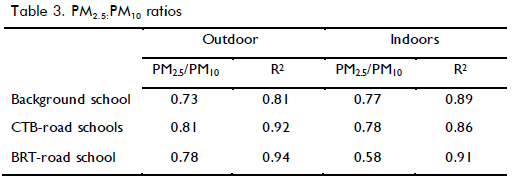
Uncertainty regarding the results and their representativeness
It has been documented that DustTrak monitor readings diverge from standard PM determination methods (Ramachandran et al., 2000; Yanosky et al., 2002). Previous studies have pointed out that readings from photometers, such as DustTrak monitors, may overestimate airborne particulate matter concentration compared to gravimetric techniques (Gorner et al., 1995; Ramachandran et al., 2000). Specific experiments were conducted during the monitoring field-campaign to validate both mass concentration methods. Integrated PM10 samples were taken daily using a Harvard Impactor with a real time instrument (DustTrak monitor). Statistics for these measurements have been previously presented by Franco et al., (2009).
Gravimetric PM10 daily concentrations ranged from10 µg/m3 to 164 µg/m3 for these particular experiments, while real-time PM10 daily concentrations were 15 µg/m3 to 182 µg/m3. The daily ratio of Dusttrak-measured mean PM10 concentration to Harvard Impactor-measured mean PM10 concentration varied considerably. It ranged from 0.3 to 4.8. Fifteen runs (i.e. 50% of all runs) showed ratios closely distributed around the unit (1 +/- 0.2); nineteen runs (i.e. more than 60% of all runs) had ratio values less than 1.
Gravimetric determinations were only conducted to asses PM10 concentration; in the present study conditions DustTrak monitors provided representative information regarding the range of PM concentration at the schools in the study. Information provided by these portable instruments should prove useful for further analysis in which specific events may be identified and characterised.
Conclusions
Particle-related air pollution was characterised in outdoor and indoor school-related microenvironments in Bogota. Based on the pollution levels found, children attending the public schools being studied were likely to be constantly exposed to high pollutant concentrations, normally exceeding reference values considered harmful for sensitive populations.
Owing to the studied schools being located only a short distance from main roads, the magnitude of traffic running directly outside each school and background PM concentration levels, it has been suggested that most air pollution in the microenvironments characterised at the busy-road schools came from mobile sources. Despite the fact that this study assessed just four schools in Bogota, this evidence represents an ongoing condition in the city which should be a main concern for the local authorities, in particular when deciding the location of future schools. The authors expect the results presented here to support the formulation of strategies aimed at minimising the population's exposure to air pollutants and improving children's living conditions. This evidence will be shared with local authorities as a significant tool regarding the design of urban planning policies in Bogota and comparable cities in Latin-America.
Acknowledgments
This study was funded by the Colombian Department of Science, Technology and Innovation (COLCIENCIAS, project 1204-04-18148), the Universidad de los Andes' School of Medicine, the Universidad Nacional de Colombia's Department of Chemical and Environmental Engineering in Bogota, Fundacion Santa Fe and the Universidad de los Andes' Urban and Regional Sustainability Studies Centre. The authors would especially like to thank the Universidad Javeriana's School of Medicine, the field-work group of students (particularly Elizabeth Zapata) and the four participating schools.
References
Bell, M. L., Davis, D. L., Gouveia, N., Borja-Aburto, V. H., Cifuentes, L. A., The avoidable health effects of air pollution in three Latin American cities, Santiago, Sao Pablo and Mexico City., Environ. Res., Vol. 100, 2006, pp. 431-440.
Bergmann, M., Kirchner, U., Vogt, R., Benter, T., On-road and laboratory investigation of low-level PM emissions of a modern diesel particulate filter equipped diesel passenger car., Atmos. Environ., Vol. 43, 2009, pp. 1908-1916.
Blondeau, P., Iordache, V., Poupard, O., Genin, D., Allard, F., Relationship between outdoor and indoor air quality in eight French schools., Indoor Air, Vol. 15, 2005, pp. 2-12.
Branis, M., Rezacova, P., Domasova, M., The effect of outdoor air and indoor human activity on mass concentrations of PM10, PM2.5, and PM1 in a classroom., Environ. Res., Vol. 99, 2005, pp. 143-149.
Calderón-Garciduenas, L., Mora-Tiscareno, A., Fordham, L. A., Chung, C. J., Rodriguez-Alcaraz, A., Paredes, R., Variakojis, D., Villareal-Calderon, A., Flores-Camacho, L., Antunez-Solis, A., Henríquez-Roldán, C., Hazucha, M. J., Respiratory damage in children exposed to urban pollution., Pediatr. Pulmonol., Vol. 36, 2003, pp. 148-161.
Calderón-Garciduenas, L., Mora-Tiscareno, A., Fordham, L. A., Chung, C. J., Valencia-Salazar, G., Flores-Gómez, S., Solt, A. C., Gomez del Campo, A., Jardón-Torres, R., Henríquez-Roldán, C., Hazucha, M. J., Reed, W., Lungradiology and pulmonaryfunction of children chronically exposed to air pollution., Environ. Health Perspect., Vol. 114, 2006, pp. 1432-1437.
CCB (Bogota's Chamber of Commerce, Bogotá D.C.), Particulate matter concentrations at an urban road with conventional public transportation system, 2006. Available at:
<http://www.corporacionambientalempresarial.org.co/documentos/Estudio_material_particulado.pdf> (accessed May 25, 2011).
Chow, J., Watson, J. G., Sah, J. J., Kiang, C. S., Loh, C., Lev-On, M., Lents, J. M., Molina, M. J., Molina, L. T., Megacities and atmospheric pollution, critical review Discussion., J. Air & Waste Manage., Vol. 54, 2004, pp.1226-1235.
DAPD (Bogota's Plannig Deparment), La estratificación en Bogotá D. C. y Estudios Relacionados 1983-2004, 2007., Bogotá D. C., Bogota´s Mayor Office.
DANE (Colombia's National Department of Statistics), Población Consolidada Departamental y Omisión Censal, CENSO 2005, 2011. Available at:
<http://www.dane.gov.co/censo/files/libroCenso2005nacional.pdf> (accessed December, 2011).
EIU (The Economist Intelligence Unit), Latin American green cities index, 2011. Available at:
<http://www.siemens.com/press/pool/de/events/corporate/2010-11-lam/Study-Latin-American-Green-City-Index_spain.pdf> (accessed December 6, 2011).
Franco, J. F., Rojas, N., Sarmiento, O. L., Hernández, L. J., Zapata, E., Maldonado, A., Matiz, L., Behrentz, E., Particulate matter concentrations at public schools located near major urban roads in Bogota, Colombia: pilot study., Rev. Fac. Ing. Univ. Antioquia, Vol. 49, 2009, pp. 101-111.
Fritz, G. J., Herbarth, O., Pulmonary function and urban pollution in preschool children., Int. J. Hyg. Environ. Health, Vol. 203, 2001, pp. 235-244.
Fromme, H., Twardella, D., Dietrich, S., Heitmann, D., Schierl, R., Liebl, B., Rüden, H., Particulate matter in the indoor air of classrooms-exploratory results from Munich and surrounding area., Atmos. Environ., Vol. 41, 2007, pp. 854-866.
Fruin, S. A., Winer, A. M., Rodes, C. E., Black carbon concentrations in California vehicles and estimation of in-vehicle diesel exhaust particulate matter exposures., Atmos. Environ., Vol. 38, 2004, pp. 4123-4133.
Gaitán, M., Cancino, J., Behrentz, E., Analysis of Bogota's air quality., Revista de Ingeniería Universidad de Los Andes, Vol. 26, 2007, pp. 81-92.
Godoy, M. L. D. P., Godoy, J. M., Roldão, L. A., Soluri, D. S., Donagemma, R. A., Coarse and fine aerosol source apportionment in Rio de Janeiro, Brazil., Atmos. Environ., Vol. 43, 2009, pp. 2366-2366. doi: 10.1016/j.atmosenv.2008.12.046.
Gorner, P., Bemer, D., Fabries, J. F., Photometer measurement of polydisperse aerosol., J. Aerosol Sci., Vol. 26, 1995, pp. 1281-1302.
Heudorf, U., Neitzert, V., Spark, J., Particulate matter and carbon dioxide in classrooms - the impact of cleaning and ventilation., Int. J. Hyg. Environ. Health, Vol. 212, 2009, pp. 45-55.
Janssen, N. A. H., van Vliet, P. H. N., Aarts, F., Harssema, H., Brunekreef, B., Assessment of exposure to traffic related air pollution of children attending schools near motorways., Atmos. Environ., Vol. 35, 2001, pp. 3875-84.
Kim, J. J., Ambient air pollution: health hazards to children., Pediatrics, Vol. 114, 2004, pp. 1699-1707.
Kim, J. J., Smorodinsky, S., Lipsett, M., Singer, B. C., Hodgson, A. T., Ostro, B., Traffic-related air pollution near busy roads: the East Bay children's respiratory health study., Am. J. Respir. Crit. Care Med., Vol. 170, 2004, pp. 520-526.
Kirchstetter, T. W., Aguiar, J., Tonse, S., Fairley, D., Novakov, T., Black Carbon Concentrations and Diesel Vehicle Emission Factors Derived from Coefficient of Haze Measurements in California: 1967-2003., Atmos. Environ., Vol. 42, 2008, pp. 480-491.
Luna, D., Behrentz, E., Estado de cuentas y nueve propuestas para el buen gobierno de Bogotá., 1st ed., Bogotá, D. C., Comunicaciones y Marketing CESA, 2011, pp. 91-121.
Nelson, P. F., Tibbett, A. R., Day, S. J., Effects of vehicle type and fuel quality on real world toxic emissions from diesel vehicles., Atmos. Environ., Vol. 42, 2008, pp. 5291-5303.
Peters, J. M., Avol, E., Gauderman, W. J., Linn, W. S., Navidi, W., London, S. J., Margolis, H., Rappaport, E., Vora, H., Gong, H. Jr., Thomas, D. C., A study of twelve Southern California communities with differing levels and types of air pollution: II. Effects on pulmonary function., Am. J. Respir. Crit. Care Med., Vol. 159, 1999, pp. 768-775.
Pope, C. A., Dockery, D. W., Health effects of fine particulate air pollution: lines that connect., J. Air & Waste Manage. Assoc., Vol. 56, 2006, pp. 709 -742.
Ramachandran, G., Adgate, J. L., Hill, N., Sexton, K., Pratt, G. C., Bock, D., Comparison of short-term variations (15-minute averages) in outdoor and indoor PM2.5 concentrations., J. Air & Waste Manage. Assoc., Vol. 50, 2000, pp. 1157-1166.
SDA (Bogota´s Environmental Department), Informe anual de calidad del aire de Bogotá 2011., Bogotá D. C., Bogota´s Mayor Office, 2012.
SDS (Bogota's Health Deparment), Births and avoidable mortality database: Comparative 2008, 2009, 2010., Bogotá D. C, Bogota´s Mayor Office, 2010.
Siemens, A. G., Megacities Challenges. A stakeholder perspective. Technical Report., 2008. Available at:
<http://www.siemens.com/entry/cc/features/urbanization_development/all/en/pdf/study_megacities_en.pdf> (accessed June 10, 2012).
Schwartz, J., Air pollution and children's health., Pediatrics, Vol. 113, 2004, pp. 1037-43.
Shprentz, D. S., Premature mortality due to particulate air pollution in 239 American cities. New York, N. Y., Natural Resources Defense Council, 1996. Available at:
<http://www.nrdc.org/air/pollution/bt/btadd.asp> (accessed December 5, 2011).
Van Roosbroeck, S., Jacobs, J., Janssen, N. A. H., Oldenwening, M., Hoek, G., Brunekreef, B., Long-term personal exposure to PM2.5, soot and NOx in children attending schools located near busy roads, a validation study., Atmos. Environ., Vol. 41, 2007, pp. 3381-3394.
WHO (World Health Organization), An assessment of health effects of ambient air pollution in Latin America and the Caribbean. Washington, D. C., Pan-American Health Organization Office, 2005.
WHO (World Health Organization), Air Quality Guidelines Global Update., Copenhagen, Europe Office, 2005.
Yanosky, J. D., Williams, P. L., MacIntosh, D. L., A Comparison of two direct-reading aerosol monitors with the Federal reference method for PM2.5 in indoor air., Atmos. Environ., Vol. 36, 2006, pp. 107-13.
References
Bell, M. L., Davis, D. L., Gouveia, N., Borja-Aburto, V. H., Cifuentes, L. A., The avoidable health effects of air pollution in three Latin American cities, Santiago, Sao Pablo and Mexico City., Environ. Res., Vol. 100, 2006, pp. 431-440. DOI: https://doi.org/10.1016/j.envres.2005.08.002
Bergmann, M., Kirchner, U., Vogt, R., Benter, T., On-road and laboratory investigation of low-level PM emissions of a modern diesel particulate filter equipped diesel passenger car., Atmos. Environ., Vol. 43, 2009, pp. 1908-1916. DOI: https://doi.org/10.1016/j.atmosenv.2008.12.039
Blondeau, P., Iordache, V., Poupard, O., Genin, D., Allard, F., Relationship between outdoor and indoor air quality in eight French schools., Indoor Air, Vol. 15, 2005, pp. 2-12. DOI: https://doi.org/10.1111/j.1600-0668.2004.00263.x
Branis, M., Rezacova, P., Domasova, M., The effect of outdoor air and indoor human activity on mass concentrations of PM10, PM2.5, and PM1 in a classroom., Environ. Res., Vol. 99, 2005, pp. 143-149. DOI: https://doi.org/10.1016/j.envres.2004.12.001
Calderón-Garciduenas, L., Mora-Tiscareno, A., Fordham, L. A., Chung, C. J., Rodriguez-Alcaraz, A., Paredes, R., Variakojis, D., Villareal-Calderon, A., Flores-Camacho, L., Antunez-Solis, A., Henríquez-Roldán, C., Hazucha, M. J., Respiratory damage in children exposed to urban pollution., Pediatr. Pulmonol., Vol. 36, 2003, pp. 148-161. DOI: https://doi.org/10.1002/ppul.10338
Calderón-Garciduenas, L., Mora-Tiscareno, A., Fordham, L. A., Chung, C. J., Valencia-Salazar, G., Flores-Gómez, S., Solt, A. C., Gomez del Campo, A., Jardón-Torres, R., Henríquez-Roldán, C., Hazucha, M. J., Reed, W., Lungradiology and pulmonary function of children chronically exposed to air pollution., Environ. Health Perspect., Vol. 114, 2006, pp. 1432-1437. DOI: https://doi.org/10.1289/ehp.8377
CCB (Bogota's Chamber of Commerce, Bogotá D.C.), Particulate matter concentrations at an urban road with conventional public transportation system, 2006. Available at: <http://www.corporacionambientalempresarial.org.co/documentos/Estudio_material_particulado.pdf> (accessed May 25, 2011).
Chow, J., Watson, J. G., Sah, J. J., Kiang, C. S., Loh, C., Lev-On, M., Lents, J. M., Molina, M. J., Molina, L. T., Megacities and atmospheric pollution, critical review Discussion., J. Air & Waste Manage., Vol. 54, 2004, pp.1226-1235. DOI: https://doi.org/10.1080/10473289.2004.10470995
DAPD (Bogota's Plannig Deparment), La estratificación en Bogotá D. C. y Estudios Relacionados 1983-2004, 2007., Bogotá D. C., Bogota’s Mayor Office.
DANE (Colombia's National Department of Statistics), Población Consolidada Departamental y Omisión Censal, CENSO 2005, 2011. Available at: <http://www.dane.gov.co/censo/files/libroCenso2005nacional.pdf> (accessed December, 2011).
EIU (The Economist Intelligence Unit), Latin American green cities index, 2011. Available at: <http://www.siemens.com/press/pool/de/events/corporate/2010-11-lam/Study-Latin-American-Green-City-Index_spain.pdf> (accessed December 6, 2011).
Franco, J. F., Rojas, N., Sarmiento, O. L., Hernández, L. J., Zapata, E., Maldonado, A., Matiz, L., Behrentz, E., Particulate matter concentrations at public schools located near major urban roads in Bogota, Colombia: pilot study., Rev. Fac. Ing. Univ. Antioquia, Vol. 49, 2009, pp. 101-111.
Fritz, G. J., Herbarth, O., Pulmonary function and urban pollution in preschool children., Int. J. Hyg. Environ. Health, Vol. 203, 2001, pp. 235-244. DOI: https://doi.org/10.1078/S1438-4639(04)70034-6
Fromme, H., Twardella, D., Dietrich, S., Heitmann, D., Schierl, R., Liebl, B., Rüden, H., Particulate matter in the indoor air of classrooms-exploratory results from Munich and surrounding area., Atmos. Environ., Vol. 41, 2007, pp. 854-866. DOI: https://doi.org/10.1016/j.atmosenv.2006.08.053
Fruin, S. A., Winer, A. M., Rodes, C. E., Black carbon concentrations in California vehicles and estimation of in-vehicle diesel exhaust particulate matter exposures., Atmos. Environ., Vol. 38, 2004, pp. 4123-4133. DOI: https://doi.org/10.1016/j.atmosenv.2004.04.026
Gaitán, M., Cancino, J., Behrentz, E., Analysis of Bogota's air quality., Revista de Ingeniería Universidad de Los Andes, Vol. 26, 2007, pp. 81-92. DOI: https://doi.org/10.16924/revinge.26.10
Godoy, M. L. D. P., Godoy, J. M., Roldão, L. A., Soluri, D. S., Donagemma, R. A., Coarse and fine aerosol source apportionment in Rio de Janeiro, Brazil., Atmos. Environ., Vol. 43, 2009, pp. 2366-2366. doi: 10.1016/j.atmosenv.2008.12.046.
Gorner, P., Bemer, D., Fabries, J. F., Photometer measurement of polydisperse aerosol., J. Aerosol Sci., Vol. 26, 1995, pp. 1281-1302. DOI: https://doi.org/10.1016/0021-8502(95)00049-6
Heudorf, U., Neitzert, V., Spark, J., Particulate matter and carbon dioxide in classrooms - the impact of cleaning and ventilation., Int. J. Hyg. Environ. Health, Vol. 212, 2009, pp. 45-55. DOI: https://doi.org/10.1016/j.ijheh.2007.09.011
Janssen, N. A. H., van Vliet, P. H. N., Aarts, F., Harssema, H., Brunekreef, B., Assessment of exposure to traffic related air pollution of children attending schools near motorways., Atmos. Environ., Vol. 35, 2001, pp. 3875-84. DOI: https://doi.org/10.1016/S1352-2310(01)00144-3
Kim, J. J., Ambient air pollution: health hazards to children., Pediatrics, Vol. 114, 2004, pp. 1699-1707. DOI: https://doi.org/10.1542/peds.2004-2166
Kim, J. J., Smorodinsky, S., Lipsett, M., Singer, B. C., Hodgson, A. T., Ostro, B., Traffic-related air pollution near busy roads: the East Bay children's respiratory health study., Am. J. Respir. Crit. Care Med., Vol. 170, 2004, pp. 520-526. DOI: https://doi.org/10.1164/rccm.200403-281OC
Kirchstetter, T. W., Aguiar, J., Tonse, S., Fairley, D., Novakov, T., Black Carbon Concentrations and Diesel Vehicle Emission Factors Derived from Coefficient of Haze Measurements in California: 1967-2003., Atmos. Environ., Vol. 42, 2008, pp. 480-491. DOI: https://doi.org/10.1016/j.atmosenv.2007.09.063
Luna, D., Behrentz, E., Estado de cuentas y nueve propuestas para el buen gobierno de Bogotá., 1st ed., Bogotá, D. C., Comunicaciones y Marketing CESA, 2011, pp. 91-121.
Nelson, P. F., Tibbett, A. R., Day, S. J., Effects of vehicle type and fuel quality on real world toxic emissions from diesel vehicles., Atmos. Environ., Vol. 42, 2008, pp. 5291-5303. DOI: https://doi.org/10.1016/j.atmosenv.2008.02.049
Peters, J. M., Avol, E., Gauderman, W. J., Linn, W. S., Navidi, W., London, S. J., Margolis, H., Rappaport, E., Vora, H., Gong, H. Jr., Thomas, D. C., A study of twelve Southern California communities with differing levels and types of air pollution: II. Effects on pulmonary function., Am. J. Respir. Crit. Care Med., Vol. 159, 1999, pp. 768-775. DOI: https://doi.org/10.1164/ajrccm.159.3.9804144
Pope, C. A., Dockery, D. W., Health effects of fine particulate air pollution: lines that connect., J. Air & Waste Manage. Assoc., Vol. 56, 2006, pp. 709 -742. DOI: https://doi.org/10.1080/10473289.2006.10464485
Ramachandran, G., Adgate, J. L., Hill, N., Sexton, K., Pratt, G. C., Bock, D., Comparison of short-term variations (15-minute averages) in outdoor and indoor PM2.5 concentrations., J. Air & Waste Manage. Assoc., Vol. 50, 2000, pp. 1157-1166. DOI: https://doi.org/10.1080/10473289.2000.10464160
SDA (Bogota’s Environmental Department), Informe anual de calidad del aire de Bogotá 2011., Bogotá D. C., Bogota´s Mayor Office, 2012.
SDS (Bogota's Health Deparment), Births and avoidable mortality database: Comparative 2008, 2009, 2010., Bogotá D. C, Bogota’s Mayor Office, 2010.
Siemens, A. G., Megacities Challenges. A stakeholder perspective. Technical Report., 2008. Available at: <http://www.siemens.com/entry/cc/features/urbanization_development/all/en/pdf/study_megacities_en.pdf> (accessed June 10, 2012).
Schwartz, J., Air pollution and children's health., Pediatrics, Vol. 113, 2004, pp. 1037-43. DOI: https://doi.org/10.1542/peds.113.S3.1037
Shprentz, D. S., Premature mortality due to particulate air pollution in 239 American cities. New York, N. Y., Natural Resources Defense Council, 1996. Available at: <http://www.nrdc.org/air/pollution/bt/btadd.asp> (accessed December 5, 2011).
Van Roosbroeck, S., Jacobs, J., Janssen, N. A. H., Oldenwening, M., Hoek, G., Brunekreef, B., Long-term personal exposure to PM2.5, soot and NOx in children attending schools located near busy roads, a validation study., Atmos. Environ., Vol. 41, 2007, pp. 3381-3394. DOI: https://doi.org/10.1016/j.atmosenv.2006.12.023
WHO (World Health Organization), An assessment of health effects of ambient air pollution in Latin America and the Caribbean. Washington, D. C., Pan-American Health Organization Office, 2005.
WHO (World Health Organization), Air Quality Guidelines Global Update., Copenhagen, Europe Office, 2005.
Yanosky, J. D., Williams, P. L., MacIntosh, D. L., A Comparison of two direct-reading aerosol monitors with the Federal reference method for PM2.5 in indoor air., Atmos. Environ., Vol. 36, 2006, pp. 107-13. DOI: https://doi.org/10.1016/S1352-2310(01)00422-8
How to Cite
APA
ACM
ACS
ABNT
Chicago
Harvard
IEEE
MLA
Turabian
Vancouver
Download Citation
CrossRef Cited-by
1. Juan Felipe Franco, Julián Felipe Segura Contreras. (2016). Exposición de peatones a la contaminación del aire en vías con alto tráfico vehicular. Revista de Salud Pública, 18(2), p.179. https://doi.org/10.15446/rsap.v18n2.49237.
2. Madina Doumbia, Adjon A. Kouassi, Siélé Silué, Véronique Yoboué, Cathy Liousse, Arona Diedhiou, N’Datchoh E. Touré, Sékou Keita, Eric-Michel Assamoi, Adama Bamba, Maurin Zouzoua, Alima Dajuma, Kouakou Kouadio. (2021). Road Traffic Emission Inventory in an Urban Zone of West Africa: Case of Yopougon City (Abidjan, Côte d’Ivoire). Energies, 14(4), p.1111. https://doi.org/10.3390/en14041111.
3. Nicole Becker Portela, Elba Calesso Teixeira, Dayana Milena Agudelo-Castañeda, Matheus da Silva Civeira, Luís Felipe Oliveira Silva, Alvaro Vigo, Prashant Kumar. (2021). Indoor-outdoor relationships of airborne nanoparticles, BC and VOCs at rural and urban preschools. Environmental Pollution, 268, p.115751. https://doi.org/10.1016/j.envpol.2020.115751.
4. Omar Ramírez, A.M. Sánchez de la Campa, Fulvio Amato, Ruth A. Catacolí, Néstor Y. Rojas, Jesús de la Rosa. (2018). Chemical composition and source apportionment of PM10 at an urban background site in a high–altitude Latin American megacity (Bogota, Colombia). Environmental Pollution, 233, p.142. https://doi.org/10.1016/j.envpol.2017.10.045.
5. Juan F. Franco, Julián F. Segura, Ivan Mura. (2016). Air Pollution alongside Bike-Paths in Bogotá-Colombia. Frontiers in Environmental Science, 4 https://doi.org/10.3389/fenvs.2016.00077.
6. Hans Orru, Annika Hagenbjörk, Henrik Olstrup. (2021). Indoor and Outdoor Nanoparticle Concentrations in an Urban Background Area in Northern Sweden: The NanoOffice Study. Environments, 8(8), p.75. https://doi.org/10.3390/environments8080075.
7. Shiva Nourani, Ana María Villalobos, Héctor Jorquera. (2025). Indoor and outdoor PM2.5 in schools of Santiago, Chile: influence of local climate zone (LCZ) environment. Air Quality, Atmosphere & Health, 18(4), p.927. https://doi.org/10.1007/s11869-024-01687-z.
Dimensions
PlumX
Article abstract page views
Downloads
License
Copyright (c) 2013 Juan Felipe Franco, Néstor Yesid Rojas, Olga Lucía Sarmiento, Eduardo Behrentz

This work is licensed under a Creative Commons Attribution 4.0 International License.
The authors or holders of the copyright for each article hereby confer exclusive, limited and free authorization on the Universidad Nacional de Colombia's journal Ingeniería e Investigación concerning the aforementioned article which, once it has been evaluated and approved, will be submitted for publication, in line with the following items:
1. The version which has been corrected according to the evaluators' suggestions will be remitted and it will be made clear whether the aforementioned article is an unedited document regarding which the rights to be authorized are held and total responsibility will be assumed by the authors for the content of the work being submitted to Ingeniería e Investigación, the Universidad Nacional de Colombia and third-parties;
2. The authorization conferred on the journal will come into force from the date on which it is included in the respective volume and issue of Ingeniería e Investigación in the Open Journal Systems and on the journal's main page (https://revistas.unal.edu.co/index.php/ingeinv), as well as in different databases and indices in which the publication is indexed;
3. The authors authorize the Universidad Nacional de Colombia's journal Ingeniería e Investigación to publish the document in whatever required format (printed, digital, electronic or whatsoever known or yet to be discovered form) and authorize Ingeniería e Investigación to include the work in any indices and/or search engines deemed necessary for promoting its diffusion;
4. The authors accept that such authorization is given free of charge and they, therefore, waive any right to receive remuneration from the publication, distribution, public communication and any use whatsoever referred to in the terms of this authorization.



